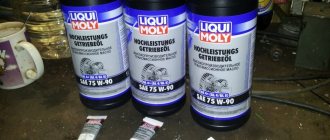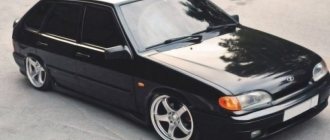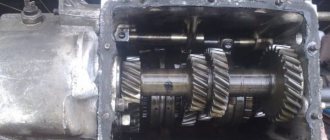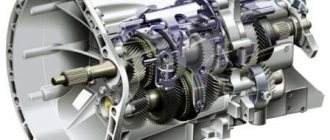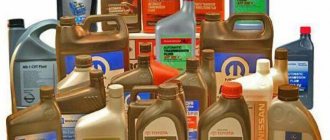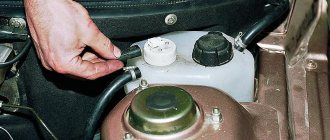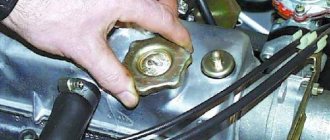Until now, despite the fact that the car is obsolete, the VAZ 21214 is popular due to its budget price, good cross-country ability and the ability to carry out many maintenance and repair operations independently. Like any other iron horse, this car needs to periodically replace technical fluids. The owner should have an idea of what materials are acceptable to use in this SUV and, in particular, what kind of oil can be poured into the 21214 engine.
Changing the oil in the transfer case Niva 21214
The Niva 21214 car is distinguished by its increased cross-country ability on roads.
The car has an engine that has a volume of 1.7 liters, which complies with Euro-4 standards. The transmission system includes a transfer case with a crankcase ventilation system. All components on the VAZ 21214, just like on the VAZ 21213, are distinguished by a long service life. It is important to properly care for the automotive system and select high-quality oil for the Niva
The Niva SUV (VAZ 2121), which has all-wheel drive and is equipped with a manual transmission, is capable of producing 75 horsepower.
Selecting gearbox oil
Which oil to choose? Transmission oils are available in a wide range
You should pay attention to fuel that has the following viscosity: 75W-90, 85W-90. In particular, you can choose gear oil Lukoil 80W90 (GL5 class)
When operating vehicles in winter, you should purchase 70W-90 oil, as it has a low viscosity. Semi-synthetic options are also suitable for refueling Niva 21213. It is better to carry out replacement at a specialized service center.
How much oil to fill? Approximately 0.8 liters of oil must be added to the Niva distributor. 1.6 liters of transmission fluid is poured into its high-speed box.
Before choosing a transmission fluid, you should always carefully study its composition.
The need to change transmission oil
To change the oil on a Niva, the car must be warmed up (to ensure good fluid fluidity). The machine is placed on an inspection hole; a special container should be placed under the drain hole into which the waste liquid will drain. To open the drain and fill plug, you should use a hexagon. Also, as an additional tool, you will need a special syringe, which is used to fill the transfer case with fuel.
Changing the oil in the transfer case (Niva 21214 / 21213). Main stages:
- The drain plug is unscrewed.
- The remaining oil is poured into the container.
- Any contamination on the plug must be eliminated.
- The drain plug is screwed in.
- The top plug is unscrewed to fill in new oil using a syringe.
- The plug is screwed in.
The peculiarity of the gearbox is that it has a built-in magnet. Its function is to attract small metal debris that may be present in the fuel.
When replacing fuel, the crankcase must be flushed. This procedure helps to extend the operational life of the box. Flushing is required if the drained oil is heavily contaminated.
The frequency of changing fuel for the transmission is affected by the mileage of the Niva 21214 (21213) and the conditions under which it is used. When making frequent off-road trips, the need to change the oil for the transfer case and gearbox may arise up to 50,000 km.
The need to add a new lubricant to the box can be indicated by the fact that the gearbox began to overheat and characteristic noises appeared on its side during movement.
Which transmission oil for a Chevrolet Niva should you choose?
Changing the oil in the variator
The Chevrolet Niva is an all-wheel drive vehicle. Properly selected oil for the transfer case, as well as all axles of an SUV, guarantees long-term operation of all vehicle transmission mechanisms. Oil helps reduce friction, which means the period of wear of parts increases significantly. The table below shows the characteristics of filling fluids for the Chevrolet Niva, taken from the official operating instructions for the car.
When choosing transmission oil for a Chevrolet Niva SUV, you should follow the recommendations of the vehicle manufacturer. It is better to purchase gear oil in special auto stores. It is best to give preference to proven, well-known brands
It is important to pay attention when buying oil for what period of the year it is intended. Oils are available for summer, winter, and all seasonal
Worth remembering! If the vehicle was purchased with mileage, then it is necessary to check the oil level. It would also be a good idea to change all the oils.
Frequency of replacement of operating fluids and lubricants
| GENERAL INFORMATION |
Changing the oil in a mechanic's box - what you need to know
Engine oil
must be replaced every 10,000 km. For a new car, it is necessary to change the oil after the break-in period (after 2500 km). When changing the oil, you must install a new oil filter (ZMZ-4062 engine) or its filter element (all engines). For the oil change procedure, see subsections 2.3.2, 2.3.2.2 and 2.3.3.3.
Into the engine crankcase
It is recommended to fill in the same brand of oil as was in the engine. If you fill in oil of a different brand, you must first flush the engine lubrication system with oil of the same brand that will be poured into the engine. To do this, drain the old oil and fill in new oil 2–4 mm above the “0” mark on the oil level indicator (dipstick). Start the engine and let it idle for about 10 minutes. Then drain the oil, replace the oil filter or its filter element and add fresh oil.
Coolant
must be changed once every 2 years or after 60,000 km (whichever comes first). For the procedure for replacing the coolant, see subsection 2.4.4. It should be borne in mind that the coolant is poisonous, so you should not suck it into your mouth when pouring it. When working with coolant, it is recommended to use safety glasses and not to smoke or eat. If the liquid gets on exposed skin, wash it with soap and water.
Gearbox oil
must be replaced after 60,000 km. For the oil change procedure, see subsections 3.3.2 and 3.4.2. Every 20,000 km, you need to check the oil level in the gearbox and top up if necessary. The oil level in the crankcase should reach the edge of the filler hole. If the drained oil contains metal particles or is very dirty, the box should be washed. To do this, pour 0.9 liters of fresh oil into its crankcase. Raise the rear of the car with a jack. Start the engine and, engaging first gear, let it run for 2-3 minutes. Then drain the oil and refill with fresh oil. When checking the oil level, you need to clean the surface of the breather from dirt and turn its cap several times to remove any dirt trapped under it.
Oil in the rear axle housing
must be changed after 60,000 km. The oil is changed in the same way as in a gearbox. After 20,000 km, you need to check the oil level in the crankcase and top up if necessary. The oil level should reach the edge of the filler hole. When checking the oil level, you need to clean the breather from dirt in the same way as you did for the gearbox.
Warning
Do not reuse drained brake fluid.
Brake fluid
In clutch and brake drives, they must be changed once every 2 years, regardless of the vehicle’s mileage.
Clutch and brake drives use domestically produced brake fluids “Rosa”, “Rosa-3”, “Tom”, “Neva” or their foreign analogues on a non-petroleum basis, the quality level of which is not lower than dot-3. The use of other brands of fluids, especially petroleum-based fluids, is prohibited
.
Brake fluid is hygroscopic, so it should not be stored in open containers.
The procedure for replacing brake fluid is as follows:
1. Remove the brake master cylinder reservoir cap.
2. Remove the rubber protective caps from the air release valves on the wheel cylinders and place rubber hoses on the valves, the ends of which are lowered into glass containers.
3. Unscrew the valves no more than one turn and, pressing the brake pedal all the way, drain the fluid. As soon as liquid stops flowing out of the hoses, tighten the air release valves.
4. Pour the drained brake fluid out of the vessels and put them in place.
5. Pour fresh fluid into the master cylinder reservoir, unscrew all air release valves one turn and, pressing the brake pedal all the way, fill the brake system. In this case, you need to constantly add fluid to the master cylinder reservoir. After clean brake fluid begins to flow out of the hoses placed on the air release valves, tighten the valves.
6. Bleed the brake system to remove air from it (see subsection 6.9).
7. Close the brake master cylinder reservoir with a plug. Remove the hoses from the air release valves and put protective caps on them.
The fluid in the clutch hydraulic drive is replaced in the same way.
Cooling liquids
| Liquid brand | Manufacturer | Regulatory document |
| Antifreeze-TS Felix | LLC "TC Tosol-Sintez", Dzerzhinsk | TU 2422-006-36732629 |
| Cool Stream Standard | JSC "Technoform", Klimovsk, Moscow region. | TU 2422-002-13331543 |
| Cool Stream Premium | JSC "Technoform", Klimovsk, Moscow region. | TU 2422-001-13331543 |
| ANTIFREEZE SINTEC | CJSC "Obninskorgsintez", Obninsk | TU 2422-047-51140047 |
| Felix Carbox | LLC "TC Tosol-Sintez", Dzerzhinsk | TU 2422-068-36732629 |
| ANTIFREEZE (antifreeze) LONGLIFE | CJSC "Dolfin Industry", Pushkino | TU 2422-163-04001396 |
Note. Service life and replacement of antifreeze in accordance with the vehicle service book. Mixing coolants of different brands is not allowed.
AIR CONDITIONING LIQUID
The air conditioner is filled with ozone-safe freon R 134 "A" Quantity - 0.4 kg
The air conditioning system uses ATMOSGU10 oil.
FLUID FOR SHOCK ABSORBERS
Liquid GRZh-12 Front shock absorber - 0.12 l Rear shock absorber - 0.195 l.
Injection 21214 eats more than VAZ 2121
Changing the oil in a Priora automatic transmission
Interior of a domestic SUV
The injector on 21214 has the following operating scheme: data on air flow, crankshaft movement, coolant temperature, engine detonation, fuel consumption, voltage in the on-board network, etc. is received from vehicle components to a number of sensors. After receiving the information, the control unit gives signals about the order of fuel supply, the operation of the ignition system, the diagnostic system, the operation of the idle air control. The injector changes injection parameters depending on the data received.
This system includes such components as sensors, a controller, the injector itself (nozzles), a fuel pump, and a pressure regulator. In it, the pump supplies fuel, the pressure regulator maintains the difference between the pressure in the injectors and the air gap in the intake manifold. And the ECU processes the information received from the sensors.
Injection engines of Niva 21214 cars, if not properly maintained, lose their efficiency, increasing fuel consumption, and often begin to stall. As a rule, the problem lies in dirty engine injectors, which cause poor mixture formation and atomization of gasoline. Cleaning the injectors can be done independently by purchasing additional materials worth about 500 rubles (including: a diamond wrench on “8”, a carburetor cleaner, a vacuum hose for the distributor, a syringe with an outlet diameter of 1 cm, an electrical cable with a toggle switch and a light bulb, rubber rings injectors, 8 pieces, O-rings for fuel pipes - 4 pieces).
At a car service center this service costs about 1,500 rubles. The injector is considered a good fuel injection system, but it is expensive, difficult to repair, requires high-quality gasoline, special diagnostic equipment and expensive repair maintenance. Therefore, many VAZ 2121 owners prefer a carburetor.
The Niva 21213 and 21214 models are more “gluttonous” than the Niva 2121. The engine on them consumes 11.5 liters in the city, 8.3 liters on the highway, and about 10.5 liters per hundred kilometers in the combined cycle according to the manufacturer’s version . In practice, for some taiga hunters, the car “eats” about 16 liters of gasoline, and in urban conditions - 13-14 liters per “hundred”.
Reinforced suspension
Engine 2130, first released in 1993, is found in the Niva 2131. Its technical parameters are as follows:
- cast iron cylinders;
- food - carburetor or injector;
- in-line type;
- four cylinders, each of which has two valves;
- cylinder diameter - 8.2 cm;
- Engine volume on model 2131 is 1.8 liters;
- power at 5200 rpm - 82 horsepower;
- torque at 3200 rpm is 139 Nm;
- engine weight 122 kg;
- oil is poured in the same volume as on the VAZ 2121 Niva;
- oil consumption from 0.7 liters per 1000 kilometers;
- service life according to the plant - 80 thousand km, according to users up to 180 thousand km
Model description
For the domestic market, the appearance of an all-terrain vehicle was a real breakthrough.
The VAZ-21214 model, which later received the name “Lada 4×4”, and is popularly called “Niva”, is a modification of the VAZ-2121 car. This four-seater passenger car, with increased cross-country ability, belongs to the class of SUVs. It is equipped with all-wheel drive, a five-speed gearbox, a transfer case, a locked center differential, has fairly good ground clearance (22 cm), a short wheelbase and small body overhangs.
The car is capable of accelerating to a speed of 142 km/h, fuel consumption (AI-92) is 10.8 l/100 km (combined cycle).
The Lada injection power unit has:
- power 80 hp;
- four cylinders (two valves each);
- volume 1.7 l;
- torque 127.5 Nm at 5200 rpm;
- distributed fuel injection (electronically controlled).
Over the years, the engine has been modernized to Euro standards. So, since 2011, it began to comply with Euro-4 toxicity standards (models for the foreign market - Euro-5).
More on the topic: Oil for Opel, recommendations for choosing
The guaranteed resource of the power unit is 80 thousand km, but usually up to 150 thousand km major repairs are not required.
VAZ 21213 Checking the oil level of a manual transmission
Checking the manual transmission oil level
Left: The inspection screw plug (1) of the manual transmission is located in the direction of travel on the right at half the height of the transmission housing. The drain plug (2) is located at the bottom of the gearbox.
Right: The fluid level in the power steering reservoir (2) must be checked with the engine running. If the tank marks are not visible, unscrew the tank cap (1) and check with a dipstick. Arrows point to marks.
A gearbox does not use oil as much as an engine and can only leak through defective seals. If no oil-soaked dirty spots are visible on the outside of the gearbox housing, then this inspection item is complete. Otherwise, you need to check the oil level. The filler (and inspection) plug is located on the left in the direction of travel at half the height of the gearbox housing next to the drive shaft.
|
| To check the atf level, pull the dipstick out of the guide tube (3) located at the rear left in the engine compartment. With warm atf, the fluid level should be in the normal range (1) between the two marks. You can check the level on the extension cord (2) even when the atf is cold. |
| Hint: manually filling with very viscous gear oil using a funnel and a long hose, even when the oil is heated, is a considerable test of your patience and for this reason is not recommended. It is better to use special canisters or a syringe with a built-in hose to add oil. |
The right grade of gear oil
You don't have to think about changing your transmission oil anymore. The transmission mechanism is equipped with a reservoir from which possible impurities are caught using a magnet.
However, gear oil must meet certain requirements. Audi prescribes the use of oil of viscosity class sae 75 w-90 with specification g 50. This is a synthetic oil.
Changing the oil in the axles of a Chevrolet Niva SUV
For this procedure, it is recommended to comply with vehicle maintenance, as well as the rules for repairing an SUV. The oil in the vehicle's axles should be changed every 40 thousand kilometers (applies to cases of Niva operation under normal conditions). If the car is operated in more difficult conditions, then the oil should be changed much earlier.
Preparation for changing the oil in Chevrolet Niva axles
Changing the oil in a vehicle's axles is identical to the procedure for changing the fluid in the transfer case. You should drive the SUV onto a viewing hole or onto a lift. The volume of oil required is the same as for the transmission. Before changing the oil, you should warm up the Niva. Next, you will need a 12mm hex key, a 17mm socket with a wrench, a container for draining the used oil, and a rag. You should also make sure you have a refill syringe.
Stages of oil change in Chevrolet Niva axles
1. Unscrew the drain plug.
2. The bolt magnet is inspected to determine whether there are chips on it. If there are no chips, the bolt is screwed back in.
3. The used oil is drained into a prepared container.
4. The drain plug is screwed in and tightened; this procedure applies to the rear axle.
5. The filler plug is unscrewed.
6. Using a filling syringe, add oil in the required volume.
7. The filler plug is wrapped and tightened again, we are talking about the rear axle.
Changing the oil in the front axle of a Chevrolet Niva is shown in more detail in the video.
For details on changing the oil in the rear axle of a Chevrolet Niva, watch the video.
Glass washing and special fluids
| Liquid brand | Manufacturer | Regulatory document |
| GLASS WASHING LIQUIDS | ||
| REVIEW-E | LLC "ASD", Tolyatti | TU 2421-001-55894651 |
| REVIEW-2 | LLC "Multipharma-Samara", Samara | TU 2384-170-00151727 |
| SPARK | NPP "Makromer", Vladimir | TU 2451-007-10488057 |
| ASPECT | CJSC "JSC ASPECT", Moscow | TU 2384-011-41974889 |
| SPECIAL LIQUIDS | ||
| NG-213 | MOPZ VNII NP, Moscow | TU 38.101-129 |
| LUKOIL AJ | LLC "Lukoil VNP", Volgograd | TU 0253-025-00148599 |
| GRG-12 | f. "VARYA", Nizhny Novgorod | TU 0253-048-05767924 |
| Pentosin Hydraulic Fluid CHS 11S | f. Pentosin, Germany | TTM 1.97.0964 |
VAZ 21213 Types and volumes of lubricants and liquids used
Types and volumes of lubricants and liquids used
Lubricants and liquids
| Component or system | Lubricant type according to specification | duckhams recommendations |
| 1. Engine | All-season motor oil with viscosity sae 10w/30, 10w/40, 5w/30 or 5w/40, api cg and g4/g5 according to CCMS specification | duckhams qxr, qs or hipergrage plus |
| 2. Cooling system | Antifreeze based on ethylene glycol | Universal duckhams antifreeze and summer coolant |
| 3. Manual transmission | 10w/30 or 10w/40 (do not use synthetic oil) | duckhams qxr or hipergrage plus |
| 4. Automatic transmission | dexron type 11 atf | duckhams uni-matic |
| 5. Constant velocity joints of drive shafts | Outer drive shaft: molicote vn 2461c Internal drive shaft: mobil gs57c lubricant | — — |
| 6. Brake hydraulic system and hydraulic clutch system | Hydraulic fluid dot 4 | Universal fluid for clutches and brakes duckhams |
| 7. Wheel hubs/bearings | Multi-purpose lithium-based grease | duckhams lb 10 |
| 8. Steering rack | Multi-purpose lithium-based grease | duckhams lb 10 |
| 9. Power steering system | Power steering fluid for saab or gm | duckhams uni-matic |
| 10. Windshield washer fluid | — | — |
Volumes
| Engine oil | |
| Taking into account the filter: | |
| Engine B202 | 4.2 l |
| Engine B234 (until 1993) | 4.3 l |
| Engines b204 and B234 (since 1994) | 5.5 l |
| Difference between max and min marks on dipstick | 1.0 l |
Cooling system
| All engines | 9.0 L (approx.) |
Manual transmission
| Until 1993 release | 2.5 l |
| Since 1994 | 1.8 l |
Automatic transmission
| Including rotation converter and fluid cooler: | |
| 2.0 L models | 8.2 L (approx.) |
| 2.3 L models | 8.7 L (approx.) |
| Required volume when replacing | 3.0 - 3.5 l |
Fuel tank
| Characteristic | |
| Models produced from 1985 to 1989 | 68 l |
| Models produced in 1990 and 1992 | 66 l |
| 1991 models | 62 l |
Power steering system
| All models | 0.75 l |
Greases
| Lubricant brand | Manufacturer | Regulatory document |
| Vaseline technical VTV-1 | JSC "Rikos", Rostov-on-Don | TU 38.301-40-21 |
| Vaseline technical ONMZ VTV-1 | JSC "Neftemaslozavod", Orenburg | TU 0255-195-05767887 |
| Lubricant AZMOL GRAPHITOL | OJSC "Azmol", Berdyansk | TU U 23.2-00152365-178 |
| LIMOL lubricant | OJSC "Azmol", Berdyansk | TU 38.301-48-54 |
| LITA grease | OJSC "Azmol", Berdyansk | TU 38.101-1308 |
| LITOL-24 lubricant | OJSC "Azmol", Berdyansk | GOST 21150 |
| Grease AZMOL LSC-15 | OJSC "Azmol", Berdyansk | TU U 23.2-00152365-180 |
| UNIROL-1 grease | JSC "Rikos", Rostov-on-Don | TU 38.301-40-23 |
| Grease UNIOL-2M/1 | OJSC "Azmol", Berdyansk | TU 38.5901243 |
| Grease AZMOL FIOL-1 | OJSC "Azmol", Berdyansk | TU U 23.2-00152365-173 |
| Grease AZMOL ShRB-4 | OJSC "Azmol", Berdyansk | TU U 23.2-00152365-172 |
| Lubricant AZMOL SHRUS-4 | OJSC "Azmol", Berdyansk | TU U 23.2-00152365-182 |
| CV joint grease-4M | OJSC "Perm Plant of Lubricants and Coolants", Perm | TU 38.401-58-128 |
| Ortol Sh lubricant | JSC "Neftemaslozavod", Orenburg | TU 0254-001-05767887 |
| Grease CIATIM-201 | OJSC "Azmol", Berdyansk, OJSC "Rikos", Rostov-on-Don, LLC NPF "RUSMA", St. Petersburg, OJSC "Neftemaslozavod", Orenburg | GOST 6267 |
| Grease CIATIM-221 | OJSC "Azmol", Berdyansk, OJSC "Rikos", Rostov-on-Don, LLC NPF "RUSMA", St. Petersburg | GOST 9433 |
Continuation of the table. 9
| Lubricant brand | Manufacturer | Regulatory document | |
| Solid lubricant Molybdol M3 | CJSC "Technology", St. Petersburg | TU 301-02-63 | |
| Lubricating graphite “P” | OJSC "Azmol", Berdyansk | GOST 8295 | |
| Ditor lubricant | JSC "Rikos", Rostov-on-Don | TU 0254-007-05766706 | |
| CASTROL S-058 grease | , Germany | TTM 1.97.733 | |
| MOLYKOTE X-106 grease | , USA | TTM 1.97.0115 | |
| Renolit JP 1619 grease | , Germany | TTM 1.97.0800 | |
| Lubricant Lucas PFG-111 | , Germany | TTM 1.97.0733 | |
Modifications
Since 1994, the manufacturer has adjusted the parameters of motor 21214 several times:
- 21214-10 (2002) – Euro-0, the first version had central gasoline injection;
- 21214-20 (2006) – Euro-2 controller Bosch MP 7.0, pairwise variable injection;
- 21214-30 (2008) – Euro-3, without power steering;
- 21214-41 (2011) – Euro-4 for the Russian Federation and Euro-5 for export, power steering, welded manifold;
- 21214-22 – Euro-2, hydraulic supports for valve levers appeared;
- 21214-31 – Euro-3, welded steel manifold, power steering pump;
- 21214-32 – Euro-3, power steering, cast iron manifold, flywheel for 215 mm clutch diameter;
- 21214-33 – Euro-3, cast iron manifold, hydraulic booster;
- 21214-34 – Euro-3, cast manifold without power steering.
Power steering 21214
Modification 21214-28 had a volume of 1.8 liters due to the larger piston stroke of 84 mm. The engine power reached 92 hp. s., and the torque is 159 Nm. In total, a little more than 69 engines of this type were produced.
Filling volumes for a VAZ 21214 car
It’s one thing to buy a car, and another to know and understand what to do with it: what to protect it from, when to “feed” it, how to operate it. No matter what kind of car you own, sooner or later you will need to refuel it. Today we will talk about the filling volumes of the VAZ 21214 and what to fill where.
First of all, let's talk about the fuel tank. Its volume in the VAZ 21214 is 42 liters (including reserve). Fill with gasoline with an octane rating of 91 to 93.
The fuel supply system is necessary to power the car engine, as well as its cleaning and storage.
The volume of the cooling system is 10.7 liters, which also includes the interior heating system. Fill in coolant whose freezing point is not higher than minus 40°C.
Cooling system - devices that provide supply of cooling medium to heated engine parts and removal of excess heat, i.e. maintaining the engine within the required thermal limits.
Engine lubrication system - 3.75 liters. It is necessary to select a specific oil, depending on the ambient temperature.
-20°С +40°С SAE 15W-40
-25°С +45°С SAE 10W-40
-30°С +45°С SAE 5W-40
-25°С +35°С SAE 10W-30
-30°С +35°С SAE 5W-30
The main task of the lubrication system is to reduce friction of mating parts. It also provides cooling of engine parts, protection against corrosion, removal of wear products and carbon deposits.
The filling volume of the gearbox housing is 1.35 liters, the transfer case housing is 0.75 liters, and the front axle housing is 1.15 liters. and rear axle housing 1.3 l. To fill these units, gear oils with a quality level corresponding to API GL-5 and a viscosity of 75W-90 are suitable.
The steering gear housing has a volume of 0.18 liters. You can add 75W-90 gear oil here.
The hydraulic brake system (0.515 liters) and clutch release system (0.2 liters) will require DOT-4, -3 brake fluid, respectively.
The volume of the windshield washer and rear door glass washer reservoir is 2 liters. You can fill it with either regular water or a mixture of water and windshield washer.
https://youtube.com/watch?v=M4OqWDFaqHM
Motor oils
| Oil brand | SAE viscosity grade | Group | Manufacturer | Regulatory document | |
| AAI | AP1 | ||||
| LUKOIL LUX | 5W-30, 5W-40 10W-40,15W-40 | B5/D3 | SJ/CF | LLC "Lukoil-Permnefteorg-sintez", Perm | STO 00044434-003 |
| LUKOIL LUX | 0W-40, 5W-20, 5W-30, 5W-50, 10W-30 | B5/D3 | SL/CF | LLC "Lukoil-Permnefteorg-sintez", Perm | STO 00044434-003 |
| TNK SUPER | 5W-30, 5W-40 10W-40 | B5/D3 | SJ/SL/CF | TNK Lubricants LLC, Ryazan | TU 0253-008-44918199 |
| TNK MAGNUM | 5W-30, 5W-40 10W-40,15W-40 | B5/D3 | SJ/SL/CF | TNK Lubricants LLC, Ryazan | TU 0253-025-44918199 |
| ROSNEFT MAXIMUM | 5W-40, 10W-40 | B5/D3 | SL/CF | OJSC "Novokuibyshevsk Oil and Additives Plant", Novokuibyshevsk | TU 0253-063-48120848 |
| ROSNEFT OPTIMUM | 10W-30, 10W-40 15W-40 | B5/D3 | SJ/CF | OJSC "Novokuibyshevsk Oil and Additives Plant", Novokuibyshevsk | TU 0253-062-48120848 |
| ROSNEFT MAXIMUM | 5W-40, 10W-40 | B5/D3 | SL/CF | OJSC "Angarsk Petrochemical Company", Angarsk | TU 0253-391-05742746 |
| ROSNEFT OPTIMUM | 10W-30, 10W-40 15W-40 | B5/D3 | SJ/CF | OJSC "Angarsk Petrochemical Company", Angarsk | TU 0253-389-05742746 |
| ROSNEFT PREMIUM | 0W-40, 5W-40 5W-40 | B5/D3 | SJ/CF SL/CF SM/CF | OJSC "Angarsk Petrochemical Company", Angarsk | TU 0253-390-05742746 |
Continuation of the table. 2
| Oil brand | SAE viscosity grade | Group | Manufacturer | Regulatory document | |
| AAI | API | ||||
| EXTRA 1 EXTRA 5 EXTRA 7 | 5W-30 15W-40 20W-50 | B5/D3 | SJ/CF | OJSC "Omsk Oil Refinery", Omsk | TU 38.301-19-137 |
| EXTRA | 5W-30, 10W-40, 15W-40 | B5/D3 | SL/CF | OJSC "Omsk Oil Refinery", Omsk | TU 38.301-19-137 |
| ESSO ULTRA | 10W-40 | B5/D3 | SJ/SL/CF | Exxon-Mobil, Germany | |
| GTTURBO SM | 10W-40 | B5 | S.M. | Hanval INC, Korea | |
| LIQUI MOLY OPTIMAL | 10W-40 | B5/D3 | SL/CF | Liqui Moly GmbH, Germany | |
| MOBIL 1 MOBIL SYNT S MOBIL SUPER S | 0W-40, 5W-50 5W-40 10W-40 | B5/D3 | SJ/SL SM/CF SJ/SL/CF | Exxon-Mobil, Germany | |
| MOBIL 1 ESP FORMULA | 5W-30 | B6/D3 | SJ/SL SM/CF | ||
| RAVENOL HPS RAVENOL VSI RAVENOL LLO RAVENOL TSI RAVENOL Turbo-C HD-C | 5W-30 5W-40 10W-40 10W-40 15W-40 | B5/D3 | SL/CF SL/CF SL/CF SL/CF SJ/CF | Ravensberger Schmirstoffvertrieb GmbH, Germany | |
| SHELL HELIX: PLUS PLUS EXTRA ULTRA | 10W-40 5W-40 5W-40 | B5/D3 | SL/CF | SHELL EAST EUROPE Co, UK, Finland | |
| ZIC A PLUS | 5W-30, 10W-30, 10W-40 | B5 | SL | SK CORPORATION, Korea | |
Note. The oil change period is in accordance with the vehicle service book.
RECOMMENDED TEMPERATURE RANGES FOR APPLICATION OF MOTOR OILS
| Minimum engine cold start temperature, 0C | Viscosity grade according to SAE J 300 | Maximum ambient temperature, 0C |
| below -35 | 0W-30 | 25 |
| below -35 | 0W-40 | 30 |
| -30 | 5W-30 | 25 |
| -30 | 5W-40 | 35 |
| -25 | 10W-30 | 25 |
| -25 | 10W-40 | 35 |
| -20 | 15W-40 | 45 |
| -15 | 20W-40 | 45 |
VAZ 21213 Changing the oil in the gearbox
The design of the gearbox does not provide for oil changes during the entire service life of the vehicle. However, sometimes the need to change the oil may arise, for example, when switching to oil with a different viscosity, when repairing a gearbox, etc.
| HELPFUL ADVICE It is recommended to drain the oil within 15 minutes after the trip, until it has cooled down and has good fluidity. |
You will need: a 13mm wrench, a syringe, a wide container for drained oil.
| NOTE Fill the gearbox with api gl-4 sae 80w-90 or sae 75w-90 oil. The manufacturer recommends replacing the oil filled at the factory with transmission oil sae 75w if the vehicle is operated for a long time at ambient temperatures below –30 °C. |
| 1. Place a container for drained oil under the gearbox, remove the bolts securing the lower gearbox cover... | 2. ...and drain the oil. |
3. Remove the cover and gasket. Wipe the cover and gasket with a clean rag to remove any remaining oil.
| NOTE It is advisable to replace the gasket with a new one each time the bottom cover is removed. |
| 4. Remove the protective cap from the oil filler plug located on top of the transmission intermediate housing. | 5. Loosen the plug... |
6. ...and turn it out.
| NOTE The oil filler plug also functions as a breather, so check that the holes in it are clean. |
| 7. Remove the inspection hole plug. | 8. Fill the oil with a syringe into the hole in the intermediate crankcase... |
9. ...until it appears from the control hole. Close the inspection hole plug.
| HELPFUL ADVICE The plug has a magnet to collect metal wear debris; clean it before installing the plug. |
10. Screw in the oil filler plug and place the protective cap on it.
| WARNING Operating a vehicle without a protective plug cap is prohibited! If it is missing, road dirt will get into the gearbox. |
Brake fluids
| Liquid brand | Manufacturer | Regulatory document |
| ROSDOT | LLC "TC Tosol-Sintez", Dzerzhinsk | TU 2451-004-36732629 |
| KAPROS-DOT | Sibur-Neftekhim LLC, Dzerzhinsk | TU 2451-030-52470175 |
Note. Service life and replacement of brake fluids in accordance with the vehicle service book, but not more than three years.


